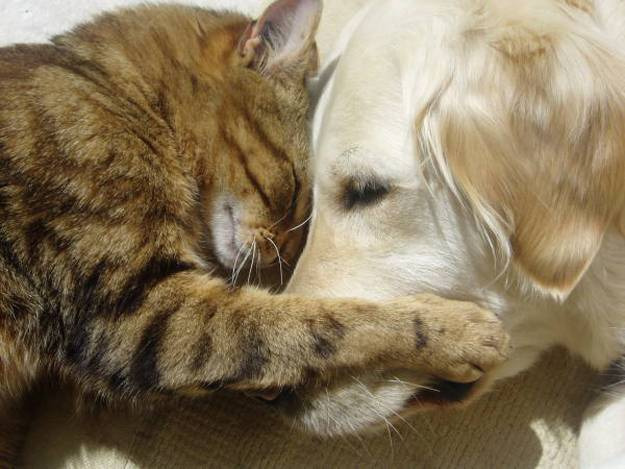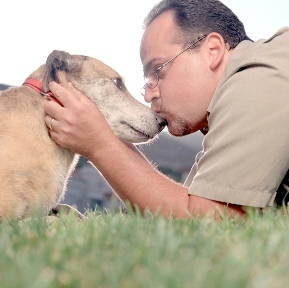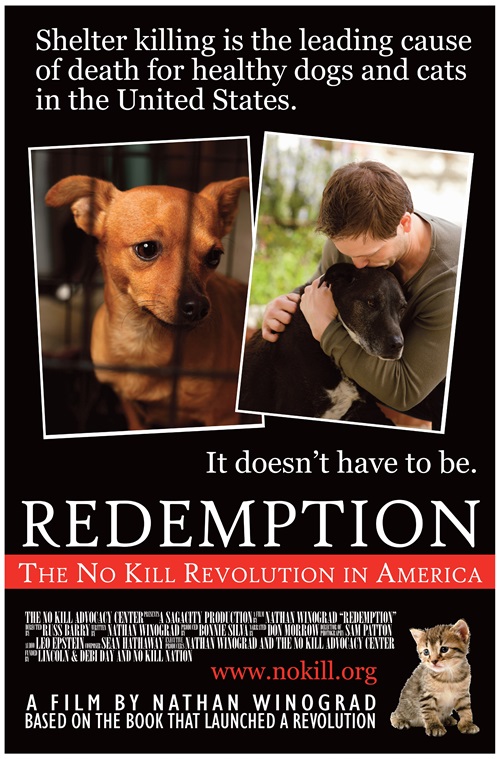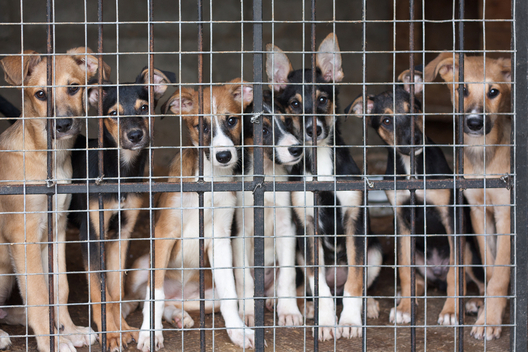Achieving a No Kill Nation: What is Happening on the Cutting Edge of the Movement – A Giveaway
About nine months ago, I was invited to a screening of a film that blew my mind. It was called Redemption: The No Kill Revolution in America. The film addressed the stark truth behind the killing of millions of companion animals in shelters each year, and introduced the exciting, growing movement to save them. A big takeaway was that overpopulation, the main reason given by shelters for the killing, was a myth, and the film supported this claim with sobering statistics. Overpopulation is an excuse we’ve believed for years. The No Kill Movement is changing all that forever. Are you up for a No Kill Nation?
The man behind the movement and the movie is Nathan Winograd. Twenty years ago, as a young upstart lawyer and animal lover, he took a concept that was working at a San Francisco SPCA and grew a community to support it. That small groundswell of shelters that were early adopters has grown into the hundreds, proving the concept with undeniable success stories. I have to admit, I felt a bit like a groupie when I interviewed Nathan back then. His ideas and what he’s been able to accomplish for animals were so exciting to me.
Like in most movements, No Kill is always pushing forward. There are new and exciting developments. Nathan and I caught up the other day and I can’t wait to share what he told me. We just helped to save 20,000 shelter animals by supporting the NBCUniversal and Telemundo’s Clear the Shelters adoption drive. The big prize – the end of euthanizing healthy, adoptable pets – is so close. Here’s what’s happened and what we can do to help.
A Giveaway
Just a quick note to let you know that at the end of this post will be a giveaway, where 10 Bark & Swagger followers can win a copy of Nathan’s film. Believe me when I tell you, it is so enlightening, so inspiring; the entire theater jumped up in thunderous applause at the end, many flocking to talk to Nathan about what they were feeling. This movie is not gratuitous. It will not show horrible images of animals being abused, sick, injured to shock you. I never felt that I had to turn away. That is not Nathan’s message, so no need to worry.
Catching up with Nathan
What’s happening in the movement
When Nathan and I spoke, he said there were three exciting things happening in the No Kill Movement right now:
- What was the opposition is now the converted (that’s big news)
- More and more communities are embracing the no kill movement in shelters, achieving a 90% save rate and higher
- More and more shelters are embracing additional types of animals, so now rabbits, guinea pigs and more are part of the high save rate
Let’s break it down…
1.
In Nathan’s best-selling book and movie, Redemption: The No Kill Movement in America, he talked about how the major players (think The American Humane Association, The Humane Society of the United States), the only shelter organizations out there at one point, were blaming the public for the over abundance of homeless pets languishing in shelters. Why did we dump them? Why didn’t we spay and neuter them? And, on and on. They ridiculed Nathan when he declared that overpopulation in shelters was a myth, despite the clear statistics showing how many animals ended up in shelters each year and how many people were looking to adopt them. Well, it took a very long time, but now, even the big, national organizations agree. “They are saying that not only is No Kill possible, but it’s achieved by changing the way the shelter is operated,” said Winograd. Amen.
All of the demographics were revealing something we already knew; that people care very deeply about animals and want to do right by them. But it also revealed that three out of four believe shelter killing should be illegal, unless the animal is suffering. People believe we have a moral duty to protect animals. So, the people have won over the hearts and minds of the big organizations. Nathan believes we’re going to see more and more of that.
2.
With more and more shelters embracing the No Kill Equation model of sheltering, they not only are achieving that 90% save rate, but more are going even higher. Michigan is a great example, according to Winograd. They just released their 2014 statistics, showing there are a number of communities now saving 97, 98, even 99% of its animals.
3.
Shelters are committing to other kinds of animals in the same way they’ve been committed to dogs and cats, the majority of whom are the ones adopted. Now, in some cases shelters are saving 100% of their rabbits and 97% of all their other animals.
Look at how far we’ve come! Back in the 1970s, when the large national groups were dominating the conversation and were the ones generating policy, there was a 10% save rate. Today, the conversation is not dominated by two or three organizations, because we have so many organizations, so many shelters and rescue groups out there. What we see now is the national average save rate is at about 65%.
What about the abuse and neglect of animals in some shelters?
That’s what I wanted to know. We hear the horror stories; we see the Facebook posts that break our hearts. Nathan is a wealth of information and suggestions on what we can do to each make a difference locally.
There are 4 things that change the status quo in shelters, and the organization he founded, the No Kill Advocacy Center (www.nokilladvocacy.org) just released a free, downloadable book that’s great for us and great for teens, too. It’s called How To Be A Superhero for Shelter Animals and teens will love it because it’s a comic book, complete with super hero-like characters. “We wanted it to be fun,” Winograd shares. “We use the old Bazooka Joe style of superhero comics, with Pows and Kablam’s. Even though the images are fun, and it’s positive, life affirming and non-judgmental, the material in it is very rigorous in terms of its power to make a lifesaving difference for animals in the community.” So, it’s not a kids book, but teens will find it appealing and will be able to digest what’s inside. The book gives people 10 different ways they can help end the suffering of animals in shelters in their community. Here are just three:
1) Start a group & take over the shelter
While this may seem like a daunting task, Winograd says you’d be surprised what a small group of animal lovers can do. He gave me an example. As Nathan tells it: “In 2011, under the old adage that if you want something done right, you do it yourself, a group of shelter volunteers in Alameda, California, told the city that had run the shelter for 126 years, that they could do a better job. And, that they could save the city money in the process. They put together a bid and the city gave them the shelter contract. So, after over 100 years of running the shelter, the city turned it over to volunteers. Those volunteers last year saved 98% of the dogs and 92% of the cats. Theyre not an aberation. In Palm Springs, CA under similar circumstances, the shelter run by the new group now saves 95% of the animals. In Petaluma, a group that took over the shelter is now saving 97%; they’re part of a growing number of shelters run by newly-formed groups that wanted the shelters run right and decided to do it themselves.”
2. Engage in political advocacy
Our tax dollars pay for these shelters and the government and shelters are supposed to reflect our values, in that regard. When they don’t, we need to engage in the political process. “That means speaking to city council, engaging the media, running public campaigns for reform and we have some powerful tools to help,” Nathan says. You can discover those tools on his website, www.nokilladvocacycenter.org.
3. Seek legislation
One of the things Nathan was most excited about is the potential for legislation to make a profound difference in whether animals live or die. He gave me three examples. As told by Nathan: “The first is in California where the state, back in 1998, made it illegal for shelters to kill animals when rescue groups were willing to save them. Why did they do that? It made no sense to legislators that the public, taxpayers in other words, were paying to kill animals when these rescue groups were willing to use their own money, philanthropic dollars, to save them. It also made no sense to legislators to kill animals who have a place to go. Before that law went into effect, a little over 12,500 animals were going from shelters to rescue groups every year. That number now stands at over 50,000 a year.
So over 37,000 animals are being saved that would’ve been killed in years past because of this legislation. Not only are we saving an additional 37,000+ animals each year, but we’re saving taxpayers $1.8 million each year from the cost of killing the animals and disposing of their bodies.”
There are others, too.
- Delaware, in 2010, passed legislation that not only mandated the same type of approach for rescue groups, but went even further. Since passing that law, the percentage of animals killed statewide has declined by 78%.
- In Austin, Texas, they went from killing 14,000 animals a year, or 68% of them, to saving 93% by passing an ordinance that made it illegal to do a whole host of things, including killing animals out of convenience, meaning killing healthy and treatable animals when there was space in the shelter. In the past, the shelter routinely killed dogs and cats, even though on some days, they had hundreds of empty cages. It was just easier to kill than clean the cages and feed or take care of the animals. Pretty outrageous, right?
Legislation is a powerful tool to save lives.
4. Force shelters to reform…by litigating
No one likes a lawsuit. But, sometimes, to protect those who can’t protect themselves, we have to go to court. When a shelter is neglecting or abusing animals, a lawsuit can make them stop. And, there is a very exciting thing happening in this movement at the moment that will make litigating a very viable way to protect and save animals’ lives.
After running shelters, writing books, making the film, consulting with shelters to help them turn around, now the area Nathan is focusing on is the creation of a Litigation Unit within the No Kill Advocacy Center. This unit will have a team of attorneys from around the country who will prosecute shelters neglecting and abusing animals. And, they’ll do it for free.
“I’ve been recruiting attorneys from all over the country to start a litigation unit, so that when shelters violate the law, when they violate the rights of rescuers and volunteers, we have attorneys who can come in, litigate the issue, get them back to legal compliance and save the lives of animals,” Winograd explained. And the method he and others have been using, successfully thus far, is via a federal law passed back in 1871 called the Ku Klux Klan Act.
What is the Ku Klux Klan Act?
This federal civil rights act today is found at 42 U.S. Code Section 1983. It’s called Section 1983, or 1983 for short. It protects individuals from a denial of civil rights by government and government actors. What it states is if government or government actors violate your civil rights, you can sue them under this federal law for what’s called declaratory and injunctive relief, which means the court will declare that your rights have been violated and enjoin or order the government to stop violating your rights, and in fact to reinstate them.
Here’s an example of how powerful Section 1983 will become to the movement. As told by Nathan: “We did a survey in New York State back in 2010, and we surveyed 500 rescue groups across the state. A little over 50% said that they are afraid to go public with inhumane conditions and inhumane treatment of animals they see in shelters because if they do, they’re afraid the shelter will prevent them from either volunteering and being able to help some animals, or if they’re rescuers, to be able to rescue some animals. They say they routinely look the other way for fear of being banned from the shelter, and we’ve seen that happen.
“So my organization, a couple of years ago, filed a civil rights lawsuit on behalf of a rescuer in L.A., who went public with allegations of mistreatment of animals. This person went to the board of supervisors, after her complaints to shelter officials fell on defiant ears, and she was banned from rescuing animals as retribution. We sued under Section 1983, arguing that this violated her First Amendment rights, both to free speech and to petition the government for a redress of grievances. The court found that the shelter indeed violated her civil rights and ordered the shelter to reinstate her as a rescuer. That was big.
“Since then, other rescue groups have sued their local shelters for banning them, after going forward with complaints about inhumane conditions and they’ve also won. So now, what started as the novel theory has turned into an unbroken line of cases where rescuers have won every single time. This is clearly a violation of their civil rights and what we want to do is to make sure that every time it happens, anywhere in the United States, that rescuer or volunteer has a lawyer who is going to court and force the shelter to reinstate them.”
Why is Section 1983 so, so important?
“That has wide-ranging ramifications, beyond rectifying the denial of civil rights for one rescuer or one volunteer, because volunteers and rescuers are not just the heart and soul of the community’s conscience, they’re the eyes and ears of the community because they’re there everyday,” Nathan affirms. “They’re the ones that see the killings, despite empty cages; they’re the ones that see employees who are socializing or laughing with their feet up on their desks, while the animals are languishing in filth, not getting enough to eat or not getting their medical needs taken care of. So, we need those people to feel safe in going forward when shelters don’t live up to the responsibility the community has placed on them as stewards of these animals. When shelters can no longer threaten volunteers or rescuers; when they can no longer hold the animals they want to save hostage or engage in retribution killing, where they kill the very animals rescuers want to save, then more volunteers and more rescuers will feel safe in going forward and force those shelters to clean up their act.” What a huge win for shelter animals!
It seems like things are already changing in shelters. They provide better care, because they can no longer shut the door and enforce the silence of their volunteers or rescuers as the condition of rescuing animals. “That doesn’t mean there still aren’t horrible shelters. There are,” Winograd states. “But, they can no longer pretend they’re doing all they can for the animals, because clearly, we’ve got the proof now, as more people come forward and testify as to what’s happening, that they’re not. So, it’s just a matter of time.”
You might be wondering, like I was, whether volunteers or rescuers who are whistleblowers, come back into the shelters after being reinstated by the court to a life of misery from the shelter staff, being impeded from doing their jobs. Apparently, that’s not legal, either. If a shelter were to violate the court’s order, then the volunteer or rescuer could go back into court, without having to file an entirely new lawsuit, and say they’re violating the court’s order. They can then be held in contempt and not just fined significantly, but potentially, jailed. Also, it makes it illegal for a shelter to ask a volunteer or rescuer to sign a Non-Disclosure Agreement. Just asking, even if you never sign, is a violation of your rights and grounds for a suit.
More about the book and film
Winograd has recently received a grant to share a copy of his film, Redemption: The No Kill Movement in America, with every rescue group and shelter in the nation. The book sold over 100,000 copies and has had a profound influence. “Someone gave them a voice in that I articulated in the book what they were feeling,” Winograd explained. “But the letters and emails from shelter directors, who read it very critically, and it still helped them to see a new way of operating and changing their policies and practices; those were very meaningful to me. One of the letters I got was from the shelter in Marquette, MI. They said they used to kill 64% of the animals, read Redemption and are now saving 98% of the animals. That’s one of the communities that was highlighted in the film. That has meant a lot to me.
“But, not everybody wants to read a book. So, I thought by making a film that didn’t just tell the story of Redemption, but told the story of what’s happened since Redemption, and the large numbers of communities across the country that used to kill a lot of animals and are now models of lifesaving, I thought that film could be a very, very powerful tool for helping communities. What better way than getting it into the hands of not just every rescue group in America, most of which will probably already agree with the message, but every shelter in America?”
Your downloadable link to How To Be A Superhero for Shelter Animals
This book gives people 10 different ways they can help end the killing of animals in their community. For each of those 10 ways, the No Kill Advocacy Center gives you links to people who have already done it, for inspiration and guidance.
Link to Superhero page with examples of what people have done
“The difference between ordinary people and extraordinary results is not that great,” says Nathan. “It’s the decision to give themselves authority to try. Anybody can do the types of things we advocate for in this guide.”
One of the things the No Kill Advocacy Center recommends for people is to do what you love; to find a way to utilize your talent and passion. Not everyone wants to form a group and take over a shelter. But, if you do what you love for the animals you love, you’ll never burn out, he says.
“We want you to feel that you can make a profound difference and that you’re only limited by your imagination.”
To find out more, to to the No Kill Advocacy Center website.
The Giveaway!
Ten (10) very lucky Bark & Swagger followers will win a copy of Nathan Winograd’s wonderful, inspiring film, Redemption: The No Kill Movement in America. I’ll repeat: there’s no gratuitous violence or violent images of animals being abused, etc. in this film. This is a very enlightening, inspiring, life-affirming film and I can’t recommend watching it enough if you’re at all interested in the shelter movement, how it began, its original mission and in learning how to stop the killing of our shelter animals.
To enter, simply join the Bark & Swagger Family by signing up to our email list. It’s fast and easy! Good luck!













I would like to receive a copy of the movie. I would try to get it, to where I could show it to the community.
Hi Cathy! Did you enter the giveaway? Or do you want to purchase a copy?
This is a wonderful article. Thanks for sharing. I saw the Redemption movie in Ithaca and read the book. Both were very enlightening. No-Kill can be done and should be done sooner rather than later.
Hi Val! Really happy you like the article. I have a real connection to this cause and to Nathan with all he’s done to advance it. So, I put my heart and soul into these pieces. Thanks so much! Great to know you’re a believer. Jody
PS – I’m already subscribed to your email but would still like to enter the giveaway for the film.:)
Ooops, I see where I can do that. FYI – you can delete this message – I just want you to check this out – http://tapinfinity.com/hero. It’s a free course I wrote with videos etc. I am going to include a link to this advocacy center pdf along with it. Funny how ideas follow the same train of thought. Thanks again for helping animals in need.
The book looks fantastic! Thanks so much for including a link to the No Kill Advocacy Center.